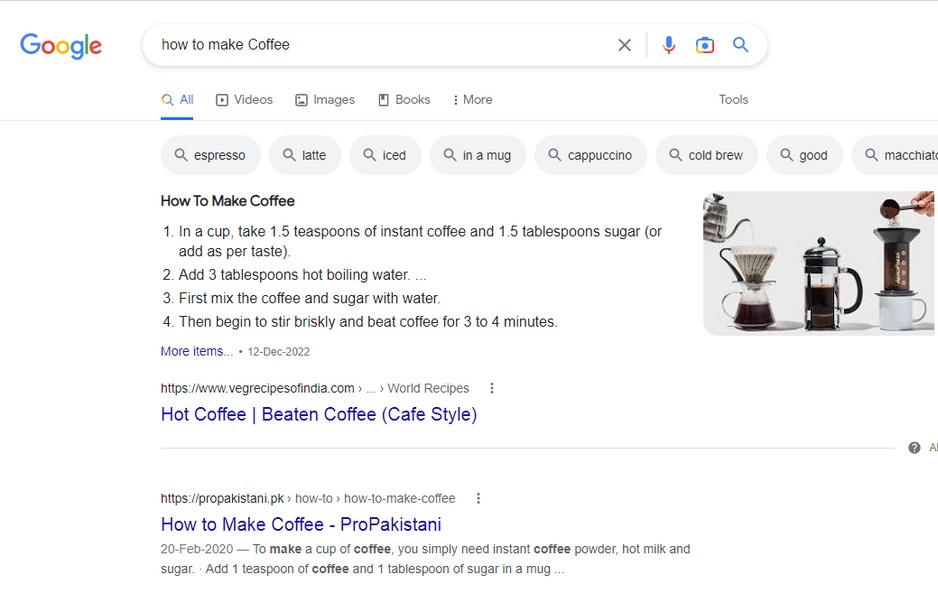Nearly a decade ago, Google’s featured snippets were first tested as an experiment.
They now frequently appear in Google’s search engine results pages (SERPs).
Highlighted snippets are now thought of as the top organic position, therefore they are a crucial component of any SEO plan.
In this article we will cover:
- What are the featured snippets?
- Types of Featured Snippets
- Why Are Featured Snippets Important?
- How to get Featured Snippets Guidelines?
- Conclusion
What are the featured snippets?
Selected search results are displayed as featured snippets below the advertising in a box on Google’s organic results page.
The goal of featured snippets is to provide a quick response to the user’s query (hence their other well-known name, “answer boxes”).
According to recent studies, featured snippets have an average click-through rate of 35%.
Being featured entails being in the most visible position and at the top of everything (apart from advertisements):
As an example, the Featured Snippet below shows the clear instructions taken from the vegrecipesofindia.com web page.

The Featured Snippet displayed in the response box is above position 1 of the SERPs for “how to make coffee” because there is no advertising for this query. Before the user needs to click a single link, the instructions are displayed in four steps.
Types of Featured Snippets:
- Paragraph
- List
- Table
- Video
- Accordion
- Rich answer
- Tool and Calculator
Paragraph
An answer to the searcher’s question in paragraph format. With 50% of all snippet results falling under this category, it is the most common form of featured snippet.

List
a numerical or bulleted list that responds to the searcher’s question (typically shows up for more process-driven, step-by-step, and list queries). With 37% of all snippet results being of this type, it is the second most common form of featured snippet.

List snippets may be numbered or have bullet points.
Table
A response to the searcher’s inquiry that contains data or other information in a table format.

Video
The page’s video response aims to provide a visual/auditory response to the searcher’s question.

Accordion
The searcher’s query is answered with extra data, which the searcher can explore to learn more about.

Rich Response
Short call-out with the searcher’s query’s resolution highlighted in bold and supporting details.
These frequently show up while trying to learn more about queries with concrete, metric-based responses.

Tool or Calculator:
A response to the searcher’s inquiry in the form of a user-specific interactive tool.
For particular and high-level questions, tools may appear. Calculators, conversions, time zones, weather, game scores, and other tools are just a few examples of the tools that Google displays.
Why Are Featured Snippets Important?
Many SEO experts quickly came to the conclusion that featured snippets would have a significant negative influence on how many users actually clicked through to the pages inside the results. In reality, this hasn’t been the case. In reality, it has markedly improved the CTR of results that are ranked within it.
How to get Featured Snippets Guidelines?
- Target inquiries that ask questions.
- The use of a schema is not required.
- Utilize headers and paragraph tags to organize the page structure.
- Use a definition-style technique for keywords that aren’t question-based.
- Include instructions about how to resolve a dilemma or respond to the query, as appropriate.
- There should be 54–58 words in the text.
- Don’t discount a global strategy.
- For featured snippets, you shouldn’t be concerned about backlinks as much.
1. Target inquiries that ask questions.
19% of the 850,000 question-based queries that Stone Temple examined had a featured snippet.
2. The use of a schema is not required.
There is a lot of contradictory information available about markup for snippets, including the notion that Google is displaying this information because of data from Schema.org. It’s safe to assume that this isn’t the case, though, given that more than 80% of the websites I’ve examined that appear in the Featured Snippet don’t make use of any Schema.org markup information.
3. Utilize headers and paragraph tags to organize the page structure.
Aside from markup, a clear page structure and the semantic relevance of the keyword in question appear to be important.
The search query should be displayed in a header somewhere on the website (h2, h3, h4, etc.). Just under the “header”, in an <p> element, should be placed the text that will be displayed in the featured snippet.
4. Use a definition-style technique for keywords that aren’t question-based.
It’s much more likely that Google will pull through a paragraph of text for shorter, less question-oriented keywords that display a featured snippet (for example, “Inbound Sales”). The majority of the time, Google prefers “solutions” that make sense and flow naturally.
5. Include instructions about how to resolve a dilemma or respond to the query, as appropriate.
Some responses demand a more thorough justification, frequently comprising a step-by-step procedure. Here, page structure is important. Each step needs to be properly arranged as a list or displayed as a header (h3) tag on the page.
6. There should be 54–58 words in the text.
The highest performance comes from information that is between 54 and 58 words long for the paragraph-style answers (not the steps).
7. Don’t discount a global strategy.
For the same query, Featured Snippets on Google.com, Google.co.uk, Google.com.au, and Google. ie sometimes contain different materials. Among many instances, try searching for “how to search on Google.”
8. For featured snippets, you shouldn’t be concerned about backlinks as much.
The best recommendation is to first perform a fast audit of the keywords that you are currently ranking for inside your existing SEO campaign to determine how many of them are question-based queries. Once you have this list, you can investigate your present rankings and the organization of your material to create a plan to reoptimize it in accordance.
Conclusion:
You can’t predict when you’ll get the results and it requires a lot of planning and research (especially if you don’t have many top 10 rankings yet), but consider it this way: Your motivation to produce better content is the possibility of being highlighted in Google search results. Along the process, you’ll accomplish the following major objectives:
- You’ll find countless fresh content ideas (and thus will rank for a wider variety of various long-tail keywords)
- You’ll become better at thoroughly researching each subject (and thus will build more incoming links because people tend to link to in-depth articles)
- You’ll discover how to better organize your articles (and thus achieve a lower bounce rate because it will be easier to read your articles)
Become a marketing expert already today and subscribe to our everyday news. Stay ahead of the latest tips and tricks to strive your business to the top!
P.S. We promise not to spam you – just the very best content for you and your loved business!













